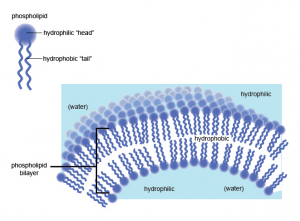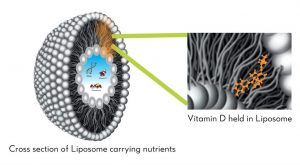Introduction to liposomes and liposomal encapsulation technology (LET)
Liposomes were first described all the way back in the early 1960s. However, their amazing benefits are only being utilized properly in more recent years.
In short, liposomal encapsulation technology (LET) is a way to get intravenous efficacy without the invasive procedure. They make the active content (medicine, vitamin, supplement…) more bioavailable and help the body absorb it better.
Before we get into the mechanisms behind this efficacy, we should have a look at why bioavailability is hampered in the first place.
Why is bioavailability a problem?
There are many reasons why a particular active content is not as efficient as it could be. Some of them depend on individual absorption capacities and some on your diet, or drugs you might be taking at the same time.
However, for most of them, bioavailability is an issue for one of the three following reasons. The active content is degraded either by the stomach acids or particular enzymes, or it is not efficiently absorbed by cells.
Liposomes and liposomal encapsulation technology (LET) address all of these problems!
What are liposomes and LET?
Liposomes are small bubbles filled with water. Their membranes are consisted of phospholipid bilayers and this is actually the reason why liposomes are so beneficial.
 Phospholipid is consisted of a head and two tails attached to it. The head is hydrophilic, which means that it looks to dwell in an aqueous surrounding. The tails, on the other hand, are lipophilic (hydrophobic), which means that they look for a fatty environment and actually turn away from water.
Phospholipid is consisted of a head and two tails attached to it. The head is hydrophilic, which means that it looks to dwell in an aqueous surrounding. The tails, on the other hand, are lipophilic (hydrophobic), which means that they look for a fatty environment and actually turn away from water.
When two layers of phospholipids are put together in an aqueous environment, their tails connect with each other on the inside of the bilayer, while the heads face outwards, towards the aqueous outside.
Making a bubble of this bilayer forms a liposome.
 The bubble is surrounded by water on the outside and filled with water on the inside. This is why the inside can carry water soluble active content. However, the middle part of the liposome membrane is consisted of the lipophilic tails, so they can carry fat soluble active convent. This makes liposomes very versatile when it comes to their application.
The bubble is surrounded by water on the outside and filled with water on the inside. This is why the inside can carry water soluble active content. However, the middle part of the liposome membrane is consisted of the lipophilic tails, so they can carry fat soluble active convent. This makes liposomes very versatile when it comes to their application.
Moreover, this is liposomal encapsulation technology (LET). Active content is encapsulated into a liposome for improved protection, delivery, absorption, bioavailability and, ultimately, efficacy.
What makes liposomes so important?
The most important feature of liposomes is the fact that their phospholipid membrane is actually the same as the membrane of cells in the body. This membrane is what protects the active content from stomach acids and enzymes. They cannot penetrate into the liposome and degrade the active content.
Much of the active content is destroyed in the GI tract, long before it can actually reach the cells that need it. This will not happen with liposomes.
However, there is another benefit in this. Just like the active content is protected from the stomach acids, the stomach is also protected from harmful side effects that some drugs have.
Next, there are many different kinds of liposomes. Aside from major quality issues that we can observe on the market, liposomes also vary in sizes. Using different sizes means that we can target the delivery route and even release timing. Depending on the active content inside the liposome and the condition it is intended to treat, using different kinds of liposomes can have a tremendous effect on efficiency.
 Lastly, when the liposome which carries the active content reaches the cell that needs it, the fact that it has a phospholipid membrane, just like the cell, produces another major benefit. This biocompatibility of the membranes enables the liposome membrane to fuse into the cell membrane releasing all the active content exactly where needed without any losses.
Lastly, when the liposome which carries the active content reaches the cell that needs it, the fact that it has a phospholipid membrane, just like the cell, produces another major benefit. This biocompatibility of the membranes enables the liposome membrane to fuse into the cell membrane releasing all the active content exactly where needed without any losses.
This means that a smaller amount of active content delivered through liposomal delivery system has more benefits than larger amounts of active content taken in orally, but degraded along the way and not absorbed completely.
However, just like with any other product, quality is paramount. We are constantly pushing the forefront of liposomes development, producing the most stable liposomes with the smallest amount of added ingredients. This already makes our liposomes market-leading products, but we are always looking to make them even better.
Can liposomal encapsulation technology (LET) be even better through ALET?
Yes, LET can be a lot better through ALET! Being around for more than half a century, liposomes are now very well researched and their benefits are familiar to most experts. However, the knowledge obtained through research has made room for further advancements in LET.
The set of current advancements enables development of now patented dry liposomes in the form of liposomal powder. More importantly than enabling further oral administration options, liposomal powder also eliminates many of the added ingredients. Liposomal powder is free of alcohol, preservatives, added flavors, scents or any additives. It also enables us to make liposomes using soy or sunflower lecithin, which opens advanced liposomal encapsulation technology for use to people who are sensitive to soy.
Liposomal powder is more pure, easier to use, can be used while travelling, more versatile and available to more people.
LET stands for liposomal encapsulation technology and describes the most beneficial delivery system which finally gives medicines, vitamins and supplements the efficacy they should have without any side effects.
ALET stands for advanced liposomal encapsulation technology and it is the next few steps in improving the benefits of LET, giving us the most bioavailable products in history without any downsides or side effects.


 Hi!
Hi!